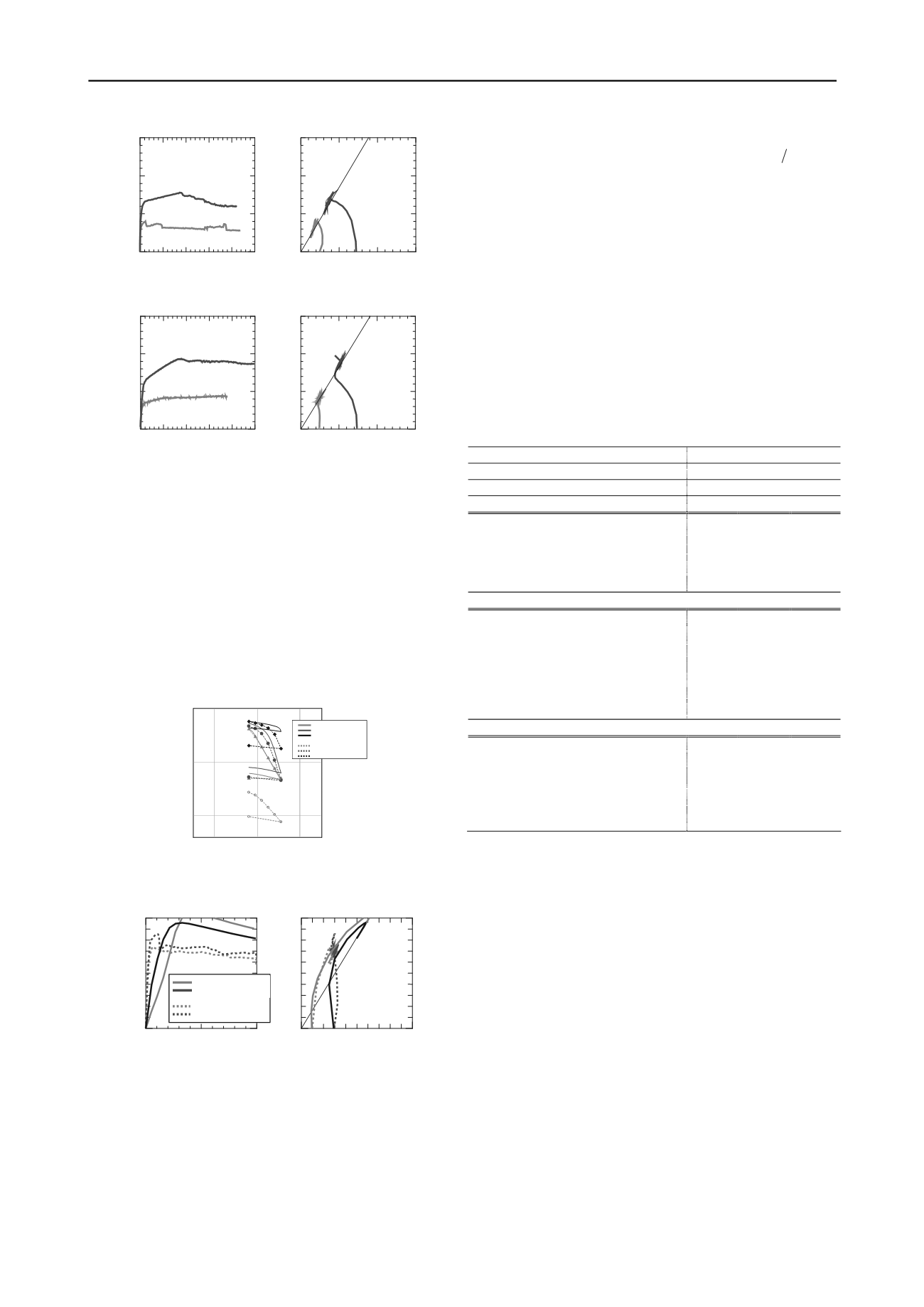
3241
Technical Committee 307 /
Comité technique 307
0 5 10 15 20 25
0
200
400
600
0
200 400 600
0
200
400
600
Axial strain
a
(%)
Deviator stress
q
(kPa)
Mean effective stress
p
(kPa)
Deviator stress
q
(kPa)
q
=M
p
(a) C=30kg/m
3
0 5 10 15 20 25
0
200
400
600
0
200 400 600
0
200
400
600
Axial strain
a
(%)
Deviator stress
q
(kPa)
Mean effective stress
p
(kPa)
Deviator stress
q
(kPa)
q
=M
p
(b) C=70kg/m
3
Figure 6. Consolidated undrained triaxial compression test results for
remolded treated soils
Fig. 7 shows the oedometer test results for treated soil and
the results reproduced using the SYS Cam-clay model. The test
results show that as the cement content is increased, the
consolidation yield stress increases, and in all cases, when the
consolidation yield stress is exceeded, high compressibility is
exhibited. For all the cement contents, it is considered that a
high structure has been produced by the addition of cement. The
analysis was generally capable of reproducing these trends.
However, as the cement content increased, the accuracy was
reduced.
10
–1
10
0
10
1
10
2
10
3
10
4
10
5
1.6
1.8
2
2.2
2.4
2.6
2.8
3
3.2
3.4
3.6
3.8
4
Verticalstress
σ
v
(kPa)
Specific volume
v
計算結果
実験結果
Calculation
Test
Specific volume
v
10 10 10 10
Vertic tress
σ
v
(kPa)
Figure 7. Treated soil standard consolidation test results and their
analytical reproduction
0
10
20
200
400
600
800
1000
0 200 400 600 800 1000
200
400
600
800
1000
Shear strain
s
(%)
Deviator stress
q
(kPa)
Mean effective stress
p
(kPa)
Deviator stress
q
(kPa)
q =
M
p
計算結果
実験結果
Calculation
Test
(c) C=70kg/m
3
Fig. 8 Consolidated undrained triaxial test results for treated soil and
their analytical reproduction
Fig. 8 shows the undrained shear test results and the
reproduced results for treated soil. The critical state line CSL
for remolded treated soil is also shown in this figure.
From the test results, the softening behavior occurs below
for treated soil with
C
=30 kg/m
3
. For treated soil with
C
=50 kg/m
3
, softening behavior occurs above
p q
M
p q
M
p q
M
under
high confining pressure. For treated soil with
C
=70 kg/m
3
, there
and a high overconsolidation ratio. As the cement content is
increased, the maximum value of the stress ratio
is distinct hardening behavior associated with plastic expansion
pq
easily
exceeds M, and for
C
=70 kg/m
3
, the effective stress
hes the
tension cut-off line (
p q
reac
3
). The analysis reproduced the
behavior of the treated
low cement content, but it was
difficult to reproduce the behavior above
p q
soil for
M
for treated
soil with a high cement content.
Table 3 shows the initial values
constants of
the
Table 3 SYS Cam-clay m
al
of the material
constants and initial values
SYS Cam-clay model used in the analysis. The addition of
cement produced high structure and pseudo overconsolidation.
Also, the overconsolidation ratio increased as the cement
content increased, but on the other hand, the extent of evolution
of structure reduced. This is considered to be due to the fact that
the water content of the dredged soil was constant in the
mixture conditions used, so as the cement content increased, the
water-cement ratio reduced, and this corresponds to the increase
of N of the remolded treated soil as the cement content
increased.
odel materi
lasticity parameters
Treated soil
P
Cement content
(kg/m
3
C=30
C=70
)
C=50
Water-cement ratio
25.2
15.0
10.6
Confining pressure (kPa)
98.1
98.1
98.1
Compression index
λ
0.21
0.36
0.51
Swelling index
κ
0.05
0.05
0.03
Limit state const
M
ant
1.70
1.60
1.65
NCL intercept
N
2.70
3.40
4.20
Poisson’s ratio
ν
0.30
0.30
0.30
Evolution rule parameters
Normal consolidated soil index
m
0.01
0.60
5.00
Structure degradation index
a
0.25
0.60
1.50
b
1.00
1.00
1.00
c
1.00
1.00
1.00
Plastic shear:plastic compression c
s
0.20
0.50
0.10
Rotation hardening index
b
r
0.00
0.00
0.00
Rotation hardening limit in
b
dex
m 0.50
0.50
0.50
Initial values
Overconsolidation ratio
0
1.03
20.9
63.8
1
/R
Extent of structure
0
�
1
/R
260
10.00
5.00
Vertical stress
σ
v
19.6
19.6
19.6
Specific volume
v
0
3.94
3.75
3.80
Stress ratio
η
0
0.00
0.00
0.00
Initial anisot
ζ
0
ropy
0.00
0.00
0.00
3 SOIL-WATER COUPLED FINITE DEFORMATION
mechanical behavior
3.1
Analysis
soil-water coupled finite
e deformation analysis code
ANALYSIS FOR TRIAXIAL TESTS
In the above, we attempted to explain the
of treated soil from the point of view of considering the triaxial
test as an element test. However, from observation of the failure
mode of the test specimens, The characteristic brittle failure had
occurred in the treated soil. Therefore, in this section, the effect
of nonuniform deformation on the triaxial test results was
investigated, taking the triaxial test to be a boundary problem.
conditions for the
init
deformation analysis
The soil-water coupled f
GEOASIA
(Noda et al. 2008), which incorporates the SYS
Cam-clay model as the constitutive equation for soil structure,
was used in the analysis. The analysis was carried out under
plane strain conditions, and Fig. 9 shows the finite element
mesh and boundary conditions. An undrained boundary was set
around the test specimen, and frictional conditions were
assumed at the top and bottom end surfaces with a rigid cap and
pedestal. A primary asymmetric mode with a cosine curve (half
period) having an amplitude of 0.005 cm (Asaoka et al. 1995)


